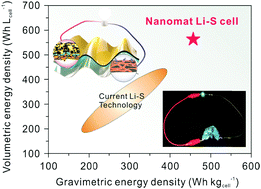当前位置:
X-MOL 学术
›
Energy Environ. Sci.
›
论文详情
Our official English website, www.x-mol.net, welcomes your
feedback! (Note: you will need to create a separate account there.)
Nanomat Li–S batteries based on all-fibrous cathode/separator assemblies and reinforced Li metal anodes: towards ultrahigh energy density and flexibility†
Energy & Environmental Science ( IF 32.4 ) Pub Date : 2018-08-14 00:00:00 , DOI: 10.1039/c8ee01879k Jung-Hwan Kim 1, 2, 3, 4, 5 , Yong-Hyeok Lee 1, 2, 3, 4, 5 , Sung-Ju Cho 1, 2, 3, 4, 5 , Jae-Gyoung Gwon 5, 6, 7, 8 , Hye-Jung Cho 5, 6, 7, 8 , Minchul Jang 5, 8, 9, 10 , Sun-Young Lee 5, 6, 7, 8 , Sang-Young Lee 1, 2, 3, 4, 5
Energy & Environmental Science ( IF 32.4 ) Pub Date : 2018-08-14 00:00:00 , DOI: 10.1039/c8ee01879k Jung-Hwan Kim 1, 2, 3, 4, 5 , Yong-Hyeok Lee 1, 2, 3, 4, 5 , Sung-Ju Cho 1, 2, 3, 4, 5 , Jae-Gyoung Gwon 5, 6, 7, 8 , Hye-Jung Cho 5, 6, 7, 8 , Minchul Jang 5, 8, 9, 10 , Sun-Young Lee 5, 6, 7, 8 , Sang-Young Lee 1, 2, 3, 4, 5
Affiliation

|
Lithium–sulfur (Li–S) batteries have attracted considerable attention as a promising alternative to current state-of-the-art lithium-ion batteries (LIBs), however, their practical use remains elusive, which becomes more serious upon application to flexible/wearable electronics. Here, we demonstrate a new class of nanomat Li–S batteries based on all-fibrous cathode–separator assemblies and conductive nonwoven-reinforced Li metal anodes as an unprecedented strategy toward ultrahigh energy density and mechanical flexibility. Sulfur cathodes, which are fibrous mixtures of sulfur-deposited multi-walled carbon nanotubes and single-walled carbon nanotubes, are monolithically integrated with bi-layered (pristine cellulose nanofiber (CNF)–anionic CNF) paper separators, resulting in metallic foil current collector-free, all-fibrous cathode–separator assemblies. The cathode–separator assemblies, driven by their all-fibrous structure (contributing to three-dimensional bi-continuous electron/ion conduction pathways) and anionic CNFs (suppressing the shuttle effect via electrostatic repulsion), improve redox kinetics, cyclability and flexibility. Nickel-/copper-plated conductive poly(ethylene terephthalate) nonwovens are physically embedded into Li foils to fabricate reinforced Li metal anodes with dimensional/electrochemical superiority. Driven by the structural uniqueness and chemical functionalities, the nanomat Li–S cells provide exceptional improvements in electrochemical performance (the (cell-based) gravimetric/volumetric energy density = 457 W h kgcell−1/565 W h Lcell−1 and the cycling performance (over 500 cycles) under 110% capacity excess of the Li metal anode) and mechanical deformability (they even can be crumpled).
中文翻译:

基于全纤维阴极/隔板组件和增强型锂金属阳极的Nanomat Li–S电池:朝着超高能量密度和灵活性的方向过渡†
锂硫(Li–S)电池作为当前最先进的锂离子电池(LIB)的有前途的替代品已引起了广泛的关注,但是,它们的实际使用仍然难以捉摸,在应用于柔性电池时变得更加严重/可穿戴电子产品。在这里,我们演示了一种基于全纤维阴极隔板组件和导电性非织造增强锂金属阳极的新型纳米级Li-S电池,这是实现超高能量密度和机械柔韧性的空前策略。硫阴极是硫沉积的多壁碳纳米管和单壁碳纳米管的纤维混合物,与双层(原始纤维素纳米纤维(CNF)–阴离子CNF)纸隔离器整体集成,从而形成金属箔集电器-自由,全纤维阴极分离器组件。阴极分离器组件由其全纤维结构(有助于三维双连续电子/离子传导途径)和阴离子CNF(抑制穿梭效应)驱动(通过静电排斥),提高氧化还原动力学,可循环性和柔韧性。镀镍/镀铜的导电聚对苯二甲酸乙二酯非织造材料物理嵌入锂箔中,以制造具有尺寸/电化学优势的增强锂金属阳极。在结构独特性和化学功能性的驱动下,纳米级Li–S电池在电化学性能方面(基于(电池)的重量/体积能量密度= 457 W h kg电池-1 / 565 W h L电池-1和循环性能(超过500个循环)(锂金属阳极的容量超出110%)和机械变形性(甚至会被压皱)。
更新日期:2018-08-14
中文翻译:

基于全纤维阴极/隔板组件和增强型锂金属阳极的Nanomat Li–S电池:朝着超高能量密度和灵活性的方向过渡†
锂硫(Li–S)电池作为当前最先进的锂离子电池(LIB)的有前途的替代品已引起了广泛的关注,但是,它们的实际使用仍然难以捉摸,在应用于柔性电池时变得更加严重/可穿戴电子产品。在这里,我们演示了一种基于全纤维阴极隔板组件和导电性非织造增强锂金属阳极的新型纳米级Li-S电池,这是实现超高能量密度和机械柔韧性的空前策略。硫阴极是硫沉积的多壁碳纳米管和单壁碳纳米管的纤维混合物,与双层(原始纤维素纳米纤维(CNF)–阴离子CNF)纸隔离器整体集成,从而形成金属箔集电器-自由,全纤维阴极分离器组件。阴极分离器组件由其全纤维结构(有助于三维双连续电子/离子传导途径)和阴离子CNF(抑制穿梭效应)驱动(通过静电排斥),提高氧化还原动力学,可循环性和柔韧性。镀镍/镀铜的导电聚对苯二甲酸乙二酯非织造材料物理嵌入锂箔中,以制造具有尺寸/电化学优势的增强锂金属阳极。在结构独特性和化学功能性的驱动下,纳米级Li–S电池在电化学性能方面(基于(电池)的重量/体积能量密度= 457 W h kg电池-1 / 565 W h L电池-1和循环性能(超过500个循环)(锂金属阳极的容量超出110%)和机械变形性(甚至会被压皱)。











































 京公网安备 11010802027423号
京公网安备 11010802027423号